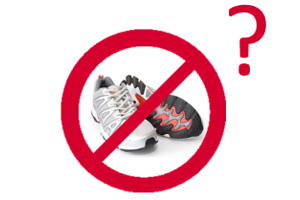5 Ways to Tell if Barefoot Running is Right for You
 The latest in performance footwear isn’t on display at America’s elite university track meets, on the basketball court or football field either. This is because the most recent innovation in athletic shoes (at least among a small but growing community of hardcore running enthusiasts) is… not wearing any at all!
The latest in performance footwear isn’t on display at America’s elite university track meets, on the basketball court or football field either. This is because the most recent innovation in athletic shoes (at least among a small but growing community of hardcore running enthusiasts) is… not wearing any at all!
For a majority of runners considering or actively experimenting with barefoot running, it’s not about trying to rediscover their inner caveman. Rather, they do this to finally improve running comfort, reduce wear and tear on their bodies and add years to their active running lives.
A 2009 bestselling book called “Born to Run”, written by Christopher McDougall, evangelizes barefoot running and ties many of our species’ running-related maladies to the use of shoes. But does running barefoot actually solve the problem? And do the obvious risks outweigh the potential benefits?
The idea is controversial among medical researchers and healthcare providers as well as among runners themselves. Evidence today doesn’t point clearly in one direction or the other. In fact, the leading researchers on the topic at Harvard University’s Skeletal Biology Lab are careful to point out that none of the information they present is meant to answer questions about how people should run and whether running barefoot or with shoes is any more likely to cause(or prevent) any particular type of injury.
Here is what to consider if you’re thinking about barefoot running:
- Shoes change the way we run. For example, long-time shoe wearers (that’s most Americans) tend to take longer strides and land further back on the foot, producing a harder heel strike that would be uncomfortable or painful without shoes. Shoe wearers also generally lean forward more. By contrast, experienced barefoot runners are far more likely to have a forefoot or midfoot strike and will tend to run in a more upright position which can be good for your joints throughout your body.
- Your body has adapted to running with shoes. The fact that most Americans wear shoes from an early age means that our bodies adapt to it. We’ve likely each adapted in a couple of different ways the most important is that we’ve learned to move differently when we wear shoes that absorb the impact and protect us from cuts and scrapes. This caused different muscles of our body to strengthen (or weaken) in the process. If you’ve “grown up” running in modern athletic shoes (which enable long strides and hard heel strikes), it’s unlikely that your feet and calves have the same muscle strength as a those of an experienced barefoot runner. It’s also unlikely that you have the same sorts of calluses.
- Shoe wearers often take harder steps that can stress the bones and joints of the entire body. The way you’ve learned to walk in shoes may have caused a greater impact and force distributed and absorbed through the body. Research suggests that the hard heel strike creates a higher-frequency impact that tends to move upward through a runner’s bones, while the lower-frequency impact of landing on the forefoot travels through the muscles and soft tissue.
- A comfortable change to your running style can take time. The last thing you want to do is inadvertently increase the risk of injury in the course of trying to prevent others. A drastic change in running style that your body hasn’t adapted to can up the odds of sprains, strains, tendonitis or stress fractures. This doesn’t mean that you can’t do something different, but it does mean that you should be smart about making a change. It can take time for you to adjust your form and for your body to adjust. For this reason, if you are going to try another style of running, I advise that you pay close attention to your technique. Your own body will provide some feedback on your progress, but allow some time to ease into it and evaluate how you’re doing.
- Form trumps all else. Whether you choose to run in shoes or to run barefoot, good form matters. And it matters a lot. Countless coaches and trainers have gone on the record saying that bad form contributes to more running-related injuries than any other single factor. Dr. Daniel Lieberman recently provided a wonderful quote to Gretchen Reynolds of the New York Times:
“Humans may have been built to run barefoot, but we did not evolve to run barefoot with bad form.”
If you’re a runner looking to try something new, especially if you are experiencing pain or have a history of injury, we can help. We’re experienced in evaluating the proper movement of your foot, ankle, hip and full body as they relate to each other, so you feel light, flexible and pain-free all over.
You can keep running at your best without the pain and find out what works best for your body so you stay active for a long time. Contact us for a free foot and ankle consultation.